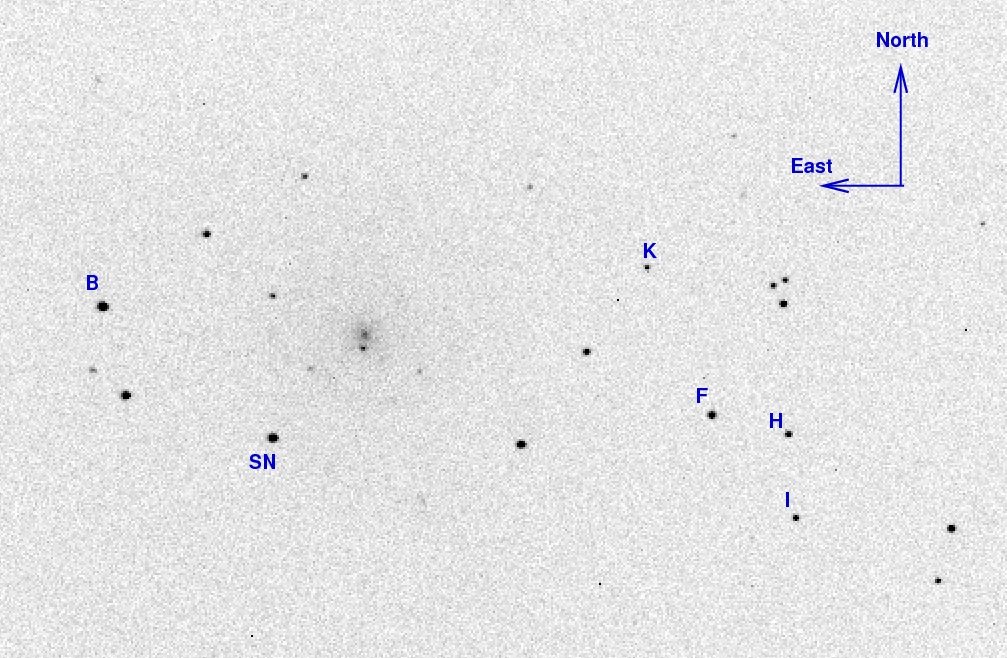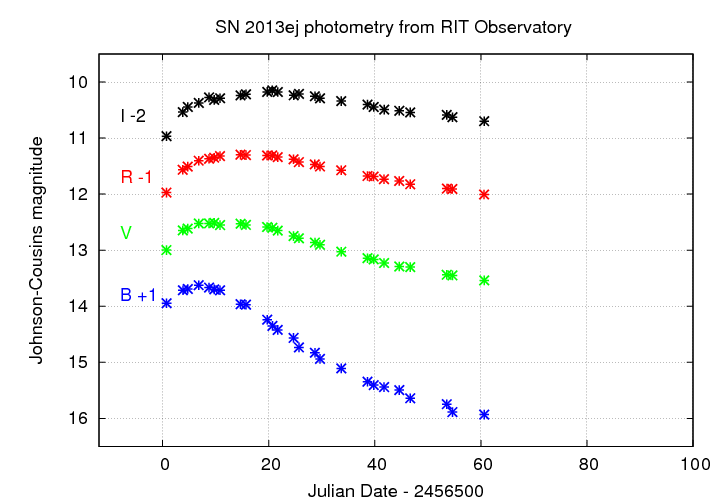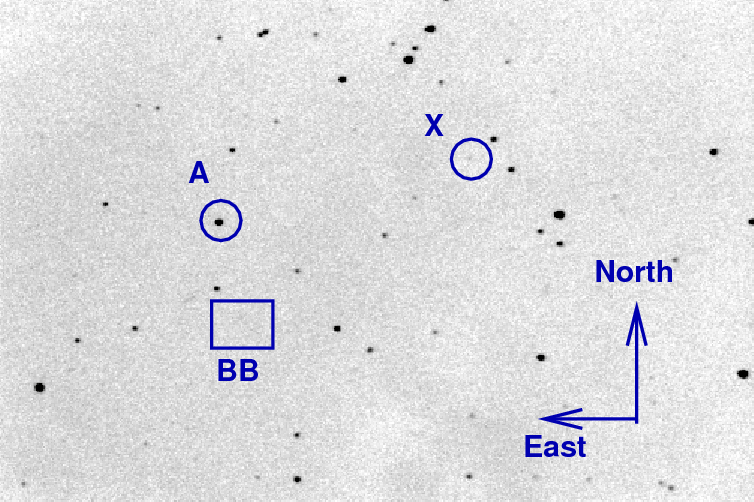
On the night of Sep 24/25, 2013, RIT physics major Brandon Doyle and I observed SN 2013ej in M74 and checked the status of upcoming HST target BB Ari. Conditions were good: clear skies, and a third-quarter Moon low on the horizon.
The main setup was:
Notes from the night
SN 2013ej is a Type II supernova in the relatively nearby galaxy M74. It was discovered by the KAIT group about one week before maximum light. Here's a chart showing the galaxy, the SN, and some reference stars:

The reference stars marked above have magnitudes in AAVSO chart 12459CA, as follows:
letter B sigB V sigV R sigR I sigI B 13.012 0.019 12.510 0.019 12.154 0.019 11.834 0.019 F 13.848 0.026 13.065 0.022 12.622 0.025 12.152 0.027 H 14.338 0.029 13.692 0.024 13.329 0.029 12.964 0.030 I 14.832 0.027 13.912 0.023 13.416 0.026 12.939 0.030 K 15.192 0.034 14.613 0.027 14.275 0.034 13.915 0.036
I took 30-second guided images in VRI, and on this night managed to guide in B-band, too. After discarding the bad images, I was left with 8, 7, 8, and 8 images in B, V, R, and I, respectively.
Using aperture photometry with a radius of 4 pixels (radius of 7.4 arcsec), I measured the instrumental magnitudes of a number of reference stars and the target. Following the procedures outlined by Kent Honeycutt's article on inhomogeneous ensemble photometry, I used all stars available in each image to define a reference frame, and measured each star against this frame. I used the AAVSO magnitudes, plus color terms to convert the ensemble instrumental magnitudes to the standard Johnson-Cousins BVRI scale.
In addition to extracting instrumental magnitudes from each individual image of the SN, I also co-added (using a median technique) all the good images in each filter to create a single image with higher signal-to-noise. Below is a comparison of the results derived from individual images to those derived from the median image:
median - individual B V R I ------------------------------------------------------------------------- Sep 11 UT -0.098 -0.016 -0.003 -0.002 Sep 18 UT 0.059 -0.005 0.009 -0.013 Sep 19 UT -0.078 0.015 -0.007 0.003 Sep 25 UT 0.019 0.006 0.009 0.006 -------------------------------------------------------------------------
I will report the results based on the median images below.
Results from this evening are:
filter mag mag_uncert Julian Date B = 14.932 +/- 0.055 (ens 0.047 zp 0.029) 2456560.63109 V = 13.538 +/- 0.055 (ens 0.018 zp 0.052) 2456560.62323 R = 13.007 +/- 0.018 (ens 0.014 zp 0.011) 2456560.61709 I = 12.699 +/- 0.026 (ens 0.019 zp 0.018) 2456560.63735
The uncertainties here are (except for B) roughly equally distributed between extracting the instrumental magnitudes and transforming the instrumental magnitudes to the standard scale.
Grab the text file below for all the RIT measurements of SN 2013ej. All these values have been recomputed with the new color terms of UT 2013 Aug 05.

BB Ari is a cataclysmic variable which is part of an observing program run by Boris Gaensicke. You can read more about the program at Boris' campaign abstract and target list.
The question was: how bright is BB Ari right now? The HST observations assume it is in its quiescent state, around V = 18.5. Since it will be observed soon, we need to know if it's still that faint.
Here's a chart based on a stack of 10 x 30-sec V-band images:

The star marked "A" has UCAC4 magnitude V = 15.193. The star marked "X", which was among the faintest I could clearly detect, has a magnitude of roughly V = 17.7. BB Ari should lie within the blue box, but I don't see any real signal there.
I concluded that BB Ari was fainter than V > 17.8 , and sent E-mail to Boris. Other people with bigger telescopes actually did measure the star on this same night, and found V = 18.4 or so. That's a good sign for the HST observations!
Last modified 09/25/2013 by MWR.